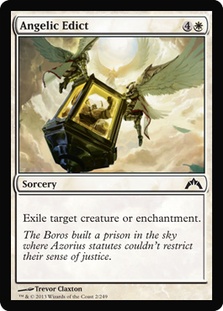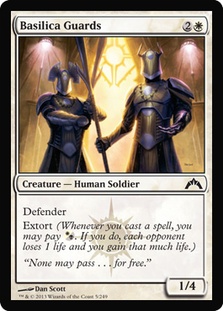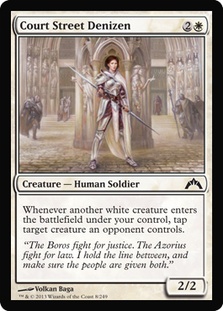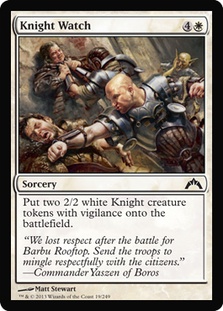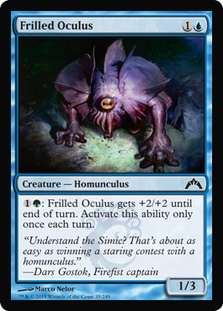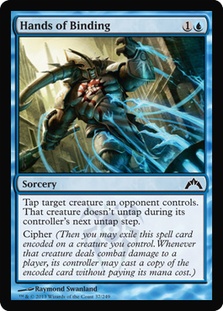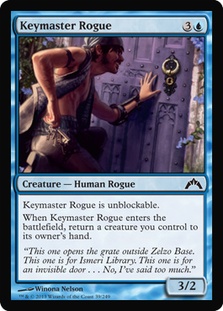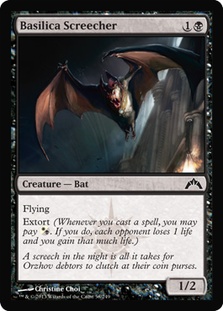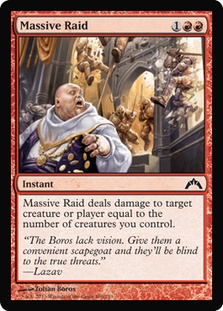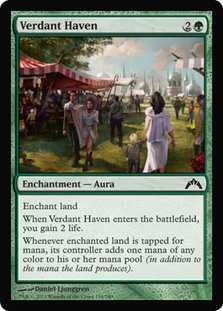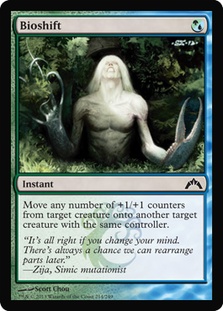As I look forward to the Gatecrash Prerelease and a new Limited season, it’s time to scour the spoiler to try to figure out as much as I can about how I expect the set to play out before playing any games. The first step to understanding any Limited format is to look closely at the commons, although ignoring the substantial impact of uncommons, especially build-around uncommons, can certainly lead to skewed expectations. Rares also always have strong impact on Limited, especially in Sealed. Still, the building blocks will be the commons.
I’ve read through the spoiler a few times and have highlighted a few commons that I think are particularly worth discussing and understanding, so let’s get to it.
White
Angelic Edict
The classic “just how much are you willing to pay for a removal spell?” kind of card. Sadly, the answer is usually “way too much,” especially in Sealed. This is a serious removal spell. It kills anything dead. The best recent comparison I can think of is Spread the Sickness, which unlike this card had real additional upside. This kills better than Spread the Sickness and can kill enchantments (which I see as an extremely minor upside), but it’s definitely a worse card overall. Fortunately for Angelic Edict, Spread the Sickness was one of the best commons in its set.
An expensive removal spell seems like the kind of thing that can vary in strength a lot based on the exact nature of the format, but I don’t think you’ll ever leave this on the bench in Sealed if you’re using any other spells that cost white mana. I also expect it to be a high pick in Draft, but I hope I’m not slamming it first pick. Sorcery speed removal is a lot worse than instant since it’s much harder to get a lot of value (a two for one) at sorcery speed, but it’s still a solid answer.
Basilica Guards
This is the perfect card for the kind of Orzhov deck I originally imagined when I read extort. Unfortunately, I’m pretty sure that’s not actually the perfect kind of extort deck. Basically, this card is a little more defensive than I want out of my aggressive mechanic. Still, it’s a creature that’s likely to stay alive and do some good blocking, and extort seems pretty sweet. On the other hand, this has to be pretty bad against Gruul.
Overall, I think this is worse than it would be in other sets. Boros and Simic will have access to bloodrush, and Gruul will have a lot of it. Dimir should be focusing on evasion, and Simic should be delighted that you’re playing a 1/4 defender instead of attacking them. Definitely playable on power level alone, but I think it’s about as badly positioned as possible.
Court Street Denizen
I wanted to talk about the Denizen cycle and how they make you want to focus on a color, but, really, most of them don’t seem particularly worth working hard for. This one is probably pretty good if you’re very aggressive, especially in Boros (which will have less evasion and reach than Orzhov due to not having as much extort and will lean more heavily on removing blockers). The fact that it triggers on creatures rather than spells means that it will be hard to tap their creatures on their turn, but it does mean that something like Knight Watch will trigger it twice, which might sometimes be a big deal.
This does make you want to try to have more white creatures in your deck, and, more importantly, it wants your creatures that cost more than three mana to be white. If you draw this with a red one- or two-drop, that doesn’t seem like a problem at all, but I can definitely see taking a random white four-drop over a random red four-drop because I have two Court Street Denizen. I have a feeling this will be a little better than people expect at first because I remember underrating Kami of Fire’s Roar at first years ago.
Knight Watch
Do you want this primarily because you’re thinking of it as a 4/4 vigilance for four, or do you want it because it gives you two attackers for battalion? Also, how does this compare to Knightly Valor? It doesn’t have the “haste” element and doesn’t let you make an evasive creature bigger or another creature big enough to attack through defenses, but it also doesn’t require a creature, isn’t vulnerable to instant speed removal, and doesn’t have any of auras’ other problems. I think it should be similar in power level to Knightly Valor overall, but for some reason it just doesn’t feel quite as good yet. That said, I’m certainly very open to it impressing me.
Blue
Cloudfin Raptor
I don’t know enough about how Simic and Dimir play to know for sure who wants this more, but it definitely seems amazing in both. I’d be surprised if this isn’t one of the best commons. It seems like it should be the start of a lot of insane openings in this format. I think it’s just a good card in a vacuum, and the fact that both builds specifically play well with its abilities definitely makes it even more important. Don’t wait until your deck already needs this kind of thing; just pick it right away and it should fit beautifully into whatever you end up doing.
Frilled Oculus
This guy’s sweet. I love a Lumengrid Warden more than one should, and Rootwalla’s generally been awesome. 1/3 is much better for evolve than 2/2, which makes this guy more desirable than he would be otherwise (unless all the guys you’re trying to evolve are the 0/4s, 1/3s, and 1/4s that Simic has a lot of in this set—then the 2/2 is actually better). One real problem with Frilled Oculus is that the Rootwalla ability best functions as a form of evasion. If you attack when you have mana up, they don’t want to block, and then you can play your spell for the turn. If you leave him back but then play your spell, all you have is a valuable 1/3 that your opponent will be happy to attack into. Obviously, 1/3s aren’t really looking for evasion, so the ability is at something of a low point here.
On the other hand, a 1/3 is relatively good (for a two-drop) at getting you to the late game, where you’re more likely to have mana available to spend. Then this guy can function as a 3/5, which is pretty huge for a two-mana creature.
Hands of Binding
This is an interesting card. You tap their creature, which makes it easier to get through with it, then you tap another creature if they had one and it couldn’t block. So this is best if they have multiple creatures but one of them was left back, likely because it was just cast, and the others attacked. Now neither of those creatures untap, but if your guy doesn’t have evasion, you can’t tap the next creature they play. Even if your guy does have evasion, this isn’t like Frost Titan. It won’t let your other guys through, and you will only get to keep one guy down.
If you’re racing guys with evasion against big guys, this is a big deal, but if your guy doesn’t have evasion, this isn’t getting you very far. On the other hand, if they only have one creature, you can keep it down forever, which means that as long as you can kill all their new creatures the old one is dead. This would still be a lot better if you had a Scroll Thief type creature, but you can always build one with other cipher spells. I think this card is playable but narrow and definitely not a high pick. I can imagine it being worse than that more easily than I can imagine it being better.
Keymaster Rogue
Is the “return a creature” a drawback or an ability? It’s almost certainly a drawback, but it won’t always function that way. The biggest question is how often you can make it work for you. First of all, it’s naturally synergistic with evolve. That’s a pretty good start. Like Cloudfin Raptor, the unblockability is naturally synergistic with cipher, so we’re back to the point where both blue guilds have a special reason to want this card. It can return itself to trigger Sage’s Row Denizen, but at four mana per that’s not going to be a high priority. Outside of evolve, I’m not seeing many good comes into play abilities to reset.
For the most part, I suspect this is going to be a drawback, which is how it’s costed since unblockable is probably slightly better than flying, so this would be a better Snapping Drake if the return a creature clause wasn’t a drawback. As is, I think it’s costed as a trivial drawback, and in reality, I think it will be a somewhat substantial drawback, especially given how fast this set looks to be. Overall, I think this means this card won’t be great unless you have a deck that’s very good at stabilizing and looking for a way to kill someone or is desperate for a reliable cipherer.
Black
Basilica Screecher
This is another card that works well in both guilds in its color. I think this is generally better than Daggerdrome Imp and that each card is better in its set than the other one would be. Daggerdrome Imp plays well with scavenge, but without that as a concern, the second toughness is nice, and this will often hit for two a turn instead of one and gain a life. I think it’s one of the best black commons, but most of the black commons look pretty weak to me at first glance.
Death’s Approach
Historically, cheap conditional removal has underperformed relative to my expectations, so I’ve readjusted. Dead Reckoning was an extremely disappointing card, and I tried to stay away from Pack’s Disdain. The upside if Death’s Approach works is pretty high. Killing a creature by giving it -x/-x for one mana is very good, but you have to have a good plan for getting creatures into your opponent’s graveyard.
What this means is that this card is going to be excellent in dedicated mill decks but almost unplayable elsewhere. The low casting cost just isn’t that useful when you can’t actually cast it in the early turns. One small piece of good news is that your opponent’s bloodrush will help turn it on, but I’d still try to stay away if I’m not milling my opponent.
Red
Massive Raid
This is an interesting card to compare to Death’s Approach. It has the same problem that it’s highly situational and not especially reliable as removal, but unlike Death’s Approach, this has the very real upside of being able to go to a player if you get a board that’s very good for it. I don’t remember exactly how much I liked Roar of the Crowd, but this is cheaper and doesn’t care about creature type, so it’s definitely better. This seems like a better card than Death’s Approach but without a home that’s as good.
Mill-based Dimir will make Death’s Approach good, whereas I don’t see a red deck that will reliably have a huge number of creatures. Boros will want three, but I don’t see any reason it will regularly have many more than that. And noncreatures that rely on you having three creatures in play really isn’t what you’re looking for in a deck where things are already going well if you have three guys. I think this card won’t fit well in this set.
Green
Verdant Haven
This is our new Axebane Guardian, and Prophetic Prism is kind of our new Gatecreeper Vine. This is slightly more reliable (harder to kill) than Axebane Guardian but is substantially weaker. It won’t let us ramp super big or fix two mana at once. This means that our multicolor green decks are going to have less mana and be less able to capitalize on random expensive bombs.
On the other hand, the fact that the card is generally weaker means that it will be easier to pick up for the decks that really want it. So with the same number of mana fixers but with them being slightly less desirable, the mana should be a little better for the people who really need it. Still, the power level is lower enough that I’m not eager to look for that kind of deck, and I think Return to Ravnica may have been less hostile to the strategy than Gatecrash, even though both sets look pretty aggressive at first.
Multicolor
Bioshift
This is the only multicolor card that really jumped out at me. It’s just a cool card. I’m not really sure of its power level, but it seems like a pretty sweet trick and is a good way to shrink an evolve creature that has gotten big enough that your other creatures aren’t triggering it so that you can get more triggers. It’s definitely not going to get snatched up by other guilds, even though its hybrid cost makes it easy to cast for anyone, because it will only be playable if you’ll consistently have +1/+1 counters, But I can definitely imagine some good plays with this. It’s another card that seems more likely to underperform than overperform though.
As a whole, the commons look pretty weak to me, which basically means that I don’t know how to utilize them yet. They can’t all be weak in context, so I look forward to seeing which ones rise up and how they play with each other.
Thanks for reading,
Sam
@samuelhblack on Twitter

